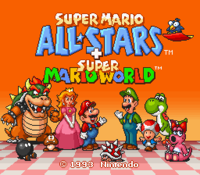Super Mario All-Stars + Super Mario World: Difference between revisions
No edit summary |
No edit summary |
||
| Line 5: | Line 5: | ||
|developer=[[Nintendo Entertainment Analysis and Development|Nintendo EAD]] | |developer=[[Nintendo Entertainment Analysis and Development|Nintendo EAD]] | ||
|publisher=[[Nintendo]] | |publisher=[[Nintendo]] | ||
|platforms=[[Super Nintendo Entertainment System]] | |platforms=[[Super Famicom]]/[[Super Nintendo Entertainment System]] | ||
|designer=[[Shigeru Miyamoto]] | |designer=[[Shigeru Miyamoto]] | ||
|released={{releasedate|USA|December, 1994|Europe|1995}} | |released={{releasedate|USA|December 1, 1994|Europe|January 21, 1995|Australia|February 3, 1995|Japan|March 14, 1995}} | ||
|genre=Platformer | |genre=Platformer | ||
|modes=1-2 players | |modes=1-2 players | ||
| Line 16: | Line 16: | ||
}} | }} | ||
[[File:Super_Mario_All-Stars_World_Title_Screen.png|thumb|left|A screenshot of the title screen.]] | [[File:Super_Mario_All-Stars_World_Title_Screen.png|thumb|left|A screenshot of the title screen.]] | ||
'''''Super Mario All-Stars + Super Mario World''''' is a compilation title for the [[Super Nintendo]]. It includes all the games from ''[[Super Mario All-Stars]]'', as well as ''[[Super Mario World]]''. It was released | '''''Super Mario All-Stars + Super Mario World''''', known in Japan, Europe and Australia as Super Mario Collection + Super Mario Bros. 4: Super Mario World, is a compilation title for the [[Super Nintendo]]. It includes all the games from ''[[Super Mario All-Stars]]'', as well as ''[[Super Mario World]]''. It was released on December 1, 1994 in North America and in 1995 in Europe, Australia and Japan. | ||
The original ''Super Mario All-Stars'' title screen changes somewhat to accompany the additional game. The background and floor color changes from blue to orange, ''Super Mario World'' is added to the logo, and [[Birdo]] moves a bit forward, and sits down to make room for [[Yoshi]], who is added in the background. | The original ''Super Mario All-Stars'' title screen changes somewhat to accompany the additional game. The background and floor color changes from blue to orange, ''Super Mario World'' is added to the logo, and [[Birdo]] moves a bit forward, and sits down to make room for [[Yoshi]], who is added in the background. | ||
Revision as of 15:20, April 24, 2013
Super Mario All-Stars + Super Mario World, known in Japan, Europe and Australia as Super Mario Collection + Super Mario Bros. 4: Super Mario World, is a compilation title for the Super Nintendo. It includes all the games from Super Mario All-Stars, as well as Super Mario World. It was released on December 1, 1994 in North America and in 1995 in Europe, Australia and Japan.
The original Super Mario All-Stars title screen changes somewhat to accompany the additional game. The background and floor color changes from blue to orange, Super Mario World is added to the logo, and Birdo moves a bit forward, and sits down to make room for Yoshi, who is added in the background.
Also, the boxart of the game has slightly changed because Super Mario World was added.
Differences from Super Mario World
Although there are no huge differences to the game unlike the other games in Super Mario All-Stars, there are a few minor differences, such as the sprites for Luigi in Super Mario World. In the original game, Luigi looks exactly like Mario except with a green outfit. In the remake, he is slimmer than Mario and performs many actions differently (for instance, Mario slides down slopes on his rear, but Luigi slides down on his knees). Luigi also spits fireballs rather than shooting them from his fingers, resembling the attack of a Fire Bro.
Mid-game saving is also incorporated, which works the same as it did in the other games.
Also, Super Mario World now has four save files similar to the rest of the games in Super Mario All-Stars, where the original version only had three, and while on the map screen, the player can press the select button to reveal the option of either continuing the game or quitting. The file select is before starting the game, in the same fashion as the other four games, and when the title screen shows, pressing a button simply brings up the number of players selection. While the other games do not allow a change in the number of players after a game is started, Super Mario World allows the player to change between one and two players even when resuming a saved game, as with the stand-alone version.
Template:BoxTop Template:Mariogames

